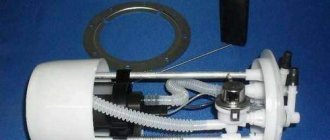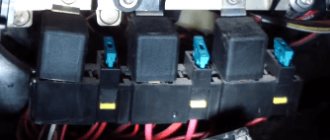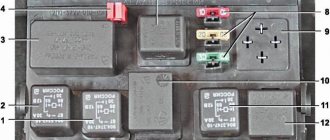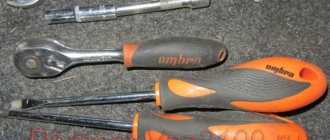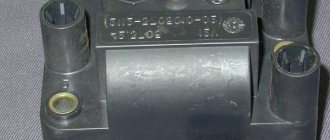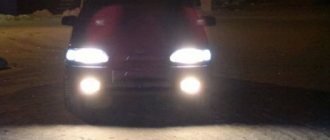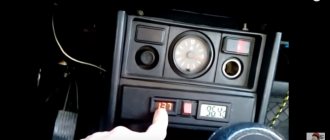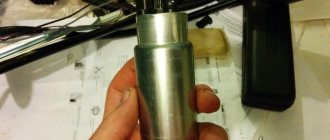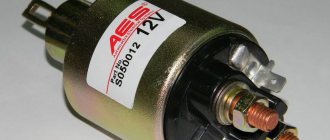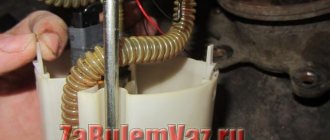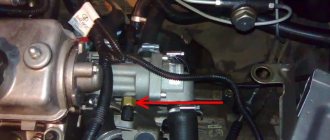The fuel pump relay is not the fuel system component that often fails. Often, problems with this relay are discovered only in a service center, although faults could be easily identified without even leaving the car. We will figure out how this relay works, how the fuel pump relay circuit works, as well as how this device works and why it is needed in general.
How to check the fuel pump relay yourself
The fuel pump relay is a device that provides and stops power supply to the fuel pump upon command from the ECU. The device is fully responsible for controlling the fuel pump, and also performs certain additional functions, which depend on the specific brand and equipment of the car. For example, on cars with automatic transmission, if it is necessary to activate the kick-down mode (intensive acceleration), the specified relay is activated.
Operating principle and design features
The VAZ 2114 fuel pump is located inside the car’s gas tank, which is why access to it can be problematic if you don’t know which side to approach. To free up access to the fuel pump, you need to remove the rear seat from the fourteenth, under which you will find a rectangular hatch hiding access to the fuel module.
Just recline the back seat and see for yourself
In addition to the pump itself, the VAZ 2114 fuel module includes:
- A float sensor that monitors the fuel level in the gas tank;
- Chamber for fuel intake;
- Mesh filter for coarse cleaning.
The gasoline pump has a built-in electric motor, which pumps up the pressure of the pumped fuel. The motor itself is powered from the vehicle's on-board network. The VAZ 2114 gasoline pump is located so that even with a minimum level of fuel in the tank, it is constantly washed with gasoline, as this is necessary for normal cooling of the unit, which gets very hot during operation.
The main working element of a gasoline pump is a membrane, which during operation performs reciprocating movements. During normal operation, when the device is fully operational, the following pressure levels must be maintained in the fuel rail:
- For 1.5 l engine. – from 285 to 326 kPa;
- For 1.6 liter engine. – from 375 to 390 kPa.
As evidenced by reviews from owners of fourteenth VAZs, in practice BOSCH pumps have proven themselves to be the best.
Unlike domestically produced units, they cost almost 20-30% more, but at the same time they have an order of magnitude better build quality and reliability. The estimated cost of the fuel module for a 1.5 liter engine of the fourteenth is 2.5 thousand rubles, for 1.6 liters. – 2.6 thousand
However, rational savings are possible here - in most cases it makes sense to purchase a fuel pump separately, rather than the entire module, since, as a rule, the pump itself “dies”, and the remaining parts of the module remain in working order. Its cost, if taken separately, is 1-1.5 tr.
Signs and Symptoms of a Bad Fuel Pump Relay
Let's start with the fact that the fuel pump is controlled through a relay according to the following general scheme:
- the driver inserts the key into the lock and turns on the ignition;
- after turning on the ignition, the relay turns on the fuel pump for 2-3 seconds, which is necessary to create pressure in the fuel rail.
- then you can hear a characteristic sound as the fuel pump relay clicks, which has turned off the fuel pump;
- subsequent operation of the fuel pump will be possible under 2 conditions: rotation of the engine by the starter during startup and further independent operation of the already running engine.
- after turning off the ignition and stopping the engine, the relay turns off the fuel pump immediately or after 1 second.
Also on some cars the device serves as a kind of engine speed limiter. If the engine speed approaches maximum and begins to exceed the permissible threshold, the fuel pump is switched off via a relay. The gasoline supply stops, the speed decreases, after which the element supplies power to the pump again.
If the relay malfunctions, then power may not be supplied to the fuel pump. The second option is that the pump hums or hums constantly, that is, it does not turn off a few seconds after the required pressure is created in the fuel line. In the first case, the engine often cannot be started because the pump does not pump and there is no gasoline in the fuel rail. In the second case, the fuel pump relay gets stuck (the fuel pump relay does not work) and the battery charge is consumed for the constant rotation of the fuel pump motor. Let us add that on some cars, starting the engine is possible even if there are certain malfunctions in the operation of the element, since the pump relay connection diagram allows the device to operate while the starter is cranking.
The video shows all the stages of diagnosing a fuel pump.
Video example: taking power from the main relay connector
If it doesn’t show correctly about + - 3 liters, then this is an error, but it’s better to install an on-board computer, it gives more accurate indicators, there’s no need to immediately go into the weeds.
My fuel pump stopped working when the engine control unit failed)).
I'm already tired of this little motor. I turn on the ignition, the relay clicks, the pump does not pump. I put my hand in the passenger’s legs, move the wires, it doesn’t help. I use a screwdriver and tap the relay. After these actions, the pump starts pumping when the ignition is turned on again.
It gets worse, now the pump fails when driving!
I searched everything there, swapped relays, fuses, felt how many wires go under the panel, nothing!
I'm so sick of this car already! It also stalls when you pull up to a traffic light at speed 3 and pull out the gear, the engine can’t hold the speed and stalls! I changed the TPS, XX, cleaned the throttle, etc., etc., the problem is not solved!
On the Drive2Ru forum, I started talking, they assured me that I’m not the only one, there are thousands like me! and no one can find the reason why the engine doesn’t keep the low speed bar and fails.
just like vibration at 100 km/h in the steering wheel.
and balanced the wheels in different service stations and changed the rims and mortars. bearings and brakes wheels, completely changed the entire suspension, the problem was NOT SOLVED! It hit the steering wheel for 100 km and continues to do so!
But the sensors are a separate issue! I constantly drove with a burning check. I'm tired of paying 450 rubles for a computer. diagnostics I bought BC ORION 10. Now it gives me errors. either low voltage at the TPS, or a knock sensor, etc. what kind of sensors are these that work so little and you need to run for a new one?
In the morning you start it, the speed is xx 1500 and rises to 2000 by itself! turned it off, started it, and it was fine. warmed up, drove off, stopped somewhere at an intersection, rpm 1300-1500 at 90C!
and this is ALWAYS the case, something is always preventing you from just driving, these little things are already infuriating!
The tire got a flat, I took it to the service station, they fixed it, pumped it up and drove on. Everything is clear here. and this electrician, it dried up the whole brain, how raw and unfit for use everything was.
some old Toyota, from the 80s, with an archaic injector does not cause such problems, everything works like a clock.
and VAZ is a car from Hell and for devils.
Check the mass air flow sensor. I had this on a viburnum and it didn’t work correctly. The voltage on it should be about.96-1.01, but mine showed 1.06. I changed it and the stalling stopped.
For me, on the contrary, I turn on the ignition, the pump works and does not turn off, I turn off the ignition, it turns off after 30 seconds.
When the ignition is turned on, the fuel pump does not work, the relays and fuses are fine. Could there be a reason for the lock? Or phase sensor - error 0343? Thank you!
- VAZ 21102 won’t start – 16 answers
- VAZ 2110 starter does not work - 7 answers
- Engine 2111 stalls immediately after starting - 5 answers
- VAZ 2110 won’t start with the key – 5 answers
- A hot VAZ 2110 engine does not start - 4 answers
This is how your error is deciphered:
P0343 Camshaft sensor signal high.
But the fuel pump should operate already at the stage of turning on the ignition, regardless of this sensor. Most likely the fuel pump itself died. Is the starter turning or what?
Checking the fuel pump relay yourself
At the beginning of the test, you need to get to the following elements: the pump fuse and its relay. Having decided which relay is responsible for the fuel pump, you should also inspect the fuse. Additionally, you need to check the fuse because the fuel pump relay heats up and then does not respond in a timely manner or does not operate at all due to a malfunction of the specified fuse.
Now let's look at another available way to check using the example of a VAZ 2110 car. The fuel pump relay itself in this model is located near the fuse.
- To check, you will need a multimeter or a test light of no more than 0.25 A. Next, you should alternately measure the voltage at the control terminals of the device, simultaneously fixing the contact to ground. This method allows you to accurately determine whether the fuel pump relay needs to be replaced.
- If the warning light does not light up, the pump fuse is working or replaced with a known working one, then attention should be paid to the wiring from the relay to the computer. At the same time, the possibility of malfunctions in the engine control unit should not be ruled out.
Finally, we add that the element may also refuse to work or stick after failures or unqualified installation of a car alarm/immobilizer. The fact is that security and anti-theft systems with an engine start blocking function are often based on interrupting the power supply to the fuel pump. In this case, these systems must be diagnosed separately.
How to determine why the fuel pump does not pump or works poorly. Fuel rail pressure, pump diagnostics. Wiring, relays, fuel pump fuses.
Purpose, design features, installation location of the fuel pressure regulator of an injection engine. Signs of RTD malfunctions, checking the device.
Why does the starter turn normally, but the engine does not catch and does not start? Main causes of malfunction, checking fuel supply and ignition systems. Adviсe.
How to remove the engine start lock. Checking for random activation of the immobilizer and how to disable it. Diagnosis of possible alarm malfunctions.
The causes of whistling and increased noise during operation of the fuel pump are overheating of the pump. How to diagnose and fix the problem yourself. Tips and tricks.
Mechanical and electric fuel pump, design and principle of operation of the device, types of pumps and main malfunctions, operating features
Key functions of the fuel pump relay
So what is a relay for? One of its main tasks is to create something like a buffer cascade between the current consumer in the on-board electrical network and the electronic control unit. The fact is that fuel pumps are equipped with DC motors, and very powerful ones at that. And a large load cannot be connected to the ECU output. And it is the relay that allows you to create control circuits to which a small current will act. This is clearly applicable to automotive electrical circuits, which include low-current control circuits and power wires to which pumps, optics, etc. are connected. As for other tasks of the fuel pump relay, there are quite a few of them:
- Lambda probe heating. In some systems, the heating was turned on when the fuel pump was turned on, while on others a separate transistor was installed for similar tasks;
- Fuel pump control. Or rather, putting the pump into operation. So that when the engine is turned on, the pressure in the fuel line immediately increases, the relay turns on the fuel supply pump for just a couple of seconds. Next, the operation of the gas pump is “monitored” by more powerful units;
- Monitoring the operation of the starting nozzle. This is relevant for the operation of a still cold engine. When the engine is “cold” the starting nozzle can work for 8-10 seconds, while on a well-warmed engine the starting nozzle can work for a few fractions of a second;
- On vehicles with automatic transmission: control of the Kick-Down function.
Spare parts for Opel Omega
Motor oil
OMEGA B sedan (25, 26, 27) (03.94 - 07.03)
Spare parts for Mitsubishi Lancer
Transmission oil LANCER IX sedan (CSA) (06.03 - 06.08)
On some cars, the fuel pump relay also performs several other functions. For example, the device can perform the tasks of a crankshaft speed limiter. If the internal combustion engine is too high, the relay starts working to turn off the electric pump . Another interesting feature: the relay turns on immediately when the driver's door is opened. This allows you to create pressure in the fuel supply system in advance, which facilitates the quick start of the power unit.
As you can see, a relay is a small but quite important component that increases the stability of several automotive systems. Relay malfunctions negatively affect the operation of the fuel pump, up to its failure and the inability to start the car. However, it should be noted that the high survivability of this element is due to well-developed circuit design - complete failure of the relay and at the same time the fuel pump is observed quite rarely.
Gasoline pump VAZ 2110 - design and repair
The VAZ 2110 fuel pump has two varieties. The first option is mechanical, built into the engine and mainly used in carburetor engines. The second option is electric, built into the fuel tank for operation on fuel-injected cars. We will consider the electric fuel pump: its design, reasons for failure, the possibility of independent maintenance or replacement.
Signs of a relay failure
The operation of the relay is important for the entire vehicle. If the part fails, the engine may not start at all or stall. In some cars, the fuel supply system is designed in such a way that even if the relay breaks down, the fuel pumps continue to operate, but the amount of fuel consumed can increase significantly. Do not neglect the problem if it occurs, as this can lead to failure of the fuel pump. The main signs of a relay failure are:
- The engine does not start because there is no fuel supplied to the system.
- A constant hum from the fuel pump means the relay is not turning it off. Such a malfunction leads to excessive fuel consumption, battery discharge and premature wear.
- The HP operates even when the motor reaches the maximum permissible speed.
All these signs are quite easy to detect, so there are no difficulties when replacing the relay to further normalize the operation of the car.
Why does the VAZ 2110 fuel pump not turn on?
If you want to start the engine with all systems in full working order (the starter rotates the engine, a spark is supplied to the spark plugs, and there is enough gasoline in the tank), you may encounter a problem with the fuel supply. The reason is that the fuel pump on your VAZ 2110 does not work. Either it broke down and no longer maintained the required pressure, or there was no power supply to it. Also, a breakdown can occur while driving, which will lead to the engine stopping.
Fig.1. Fuel supply diagram for an engine with a fuel injection system: 1 - injectors; 2 — fitting plug for monitoring fuel pressure; 3 — injector ramp; 4 — bracket for fastening fuel pipes; 5 — fuel pressure regulator; 6 — adsorber with solenoid valve; 7 — hose for suction of gasoline vapors from the adsorber; 8 — throttle assembly; 9 - two-way valve; 10 - gravity valve; 11 - safety valve; 12 - separator; 13 — separator hose; 14 — fuel tank plug; 15 - filling pipe; 16 — filling pipe hose; 17 — fuel filter; 18 — fuel tank; 19 — electric fuel pump; 20 — fuel drain line; 21 - fuel supply line.
How to check the fuel pump on a VAZ 2110 injector 8 valves
If the electric fuel pump on a VAZ 2110 simulates operation, but the car does not start, then it is necessary to measure the pressure in the fuel system. To do this, you should purchase (use) a tire pressure gauge, a piece of fuel hose, a 7/16-20 UNF fitting adapter and clamps. The parts must be connected to each other.
Then, relieve the pressure in the system and attach the structure to the fuel rail at the edge. Start the engine. The arrow on the pressure gauge will begin to show values. The following indicators are considered normal: 280-320 kPa (2.8-3.2 kg/cm2) at idle. At high speeds: 280-350 kPa (2.8-3.5 kg/cm2). If the indicator is less, you should remove the fuel pump module from the tank.
This diagnostic method allows you to narrow the range of faults, which include:
- faulty rail pressure regulator;
- insufficient fuel supply from the pump;
- clogging of the fuel system (mesh filter).
Sometimes, replacing or cleaning the strainer on the pump body helps eliminate the problem and the pressure is restored.
No power to the fuel pump VAZ 2110 injector
A harness of three wires is connected to the pump: “plus”, “minus” and fuel level. In order to check the power supply, you need to use an electrical voltage tester. In its absence, a 12 V control light will help. By closing the circuit, it becomes immediately clear whether power is coming to the unit or not.
If, as a result of the check, it turns out that your VAZ 2110 does not have power for the fuel pump relay, then you need to check the “negative” and “positive” wires separately. For example, take the mass from the car body, and “throw” the plus from the battery.
Signs of a fuel pump failure
A faulty fuel pump is quite easy to identify, since it is characterized by characteristic signs of failure. For example: while driving, the car suddenly stalls - after turning it on again, the engine begins to make uncharacteristic sounds, while the starter does not stop turning. After the car starts up, the picture repeats itself - the fourteenth engine stalls again. It is also possible that the car starts every once in a while - problems usually arise after sitting at neutral speed.
Let's determine the most typical signs of a fuel pump malfunction:
- The engine refuses to start. Of course, there can be many reasons for this problem - the same spark plugs, or the ECU, but the possibility of a fuel pump malfunction is also worth taking into account;
- The pressure level in the fuel relay differs from normal values;
- The motor is tripping. As a rule, if the fuel pump does not pump as it should, the engine begins to twitch quite noticeably because gasoline is not burned properly in the working cylinders;
- The engine growls at low speeds. One of the most truthful signs, which indicates either an immediate breakdown of the pump, or that the low-purity filter is clogged and the mesh needs to be replaced.
There are quite a lot of possible breakdowns that could cause the fuel pump to fail. The following parts of the unit design can present an unexpected surprise: fuse, fuel pump relay, ground, electric motor, contact system. Let's look at each of them separately.
Pressure level
In order to get most of the picture of what is happening, it is enough to measure the pressure in the fuel rail. For this, it is necessary to use a pressure gauge that has a small measurement range (preferably up to 7 atmospheres), since devices with a large range can produce significant inaccuracies.
Rail pressure measurement
Under the hood of the fourteenth there is a pressure fitting; unscrew its cap and connect the pressure gauge to it.
Normal indicators should be as follows:
- When the engine is idling – 2.5 kPa;
- At the moment of ignition - 3 kPa;
- With a pinched drain hose – 7 kPa;
- When gaining speed - 2.5-3 kPa.
If the pressure gauge needle does not move when the ignition is turned on, then the gasoline pressure regulator is most likely broken. When there is no change as the speed increases, the fuel pump itself has failed, but if the needle moves very slowly, which indicates that the pump is pumping, but poorly, the fuel pump screen is clogged.
How to test wiring with a multimeter
If the fuel pump does not work, do not rush to change it - perhaps the problem is in poor-quality wiring. There are 3 wires connected to the pump: to the gasoline level sensor, and positive and negative to power the motor.
No special tools are required to check the wiring - a regular 12-volt light bulb is enough. We connect the light bulb to the negative and positive wires of the pump, and turn on the car’s ignition - if the light blinks, then everything is fine with the wiring.
Fuel pump motor
When you have determined that the external wiring of the fuel pump is normal, you need to move on to checking the motor. This is done with the same light bulb, the wires of which are connected to the external terminals of the motor. If the light comes on when you turn on the ignition, then you need to change the motor.
Fuel pump ground and relay
In the fourteenth, the mass of the fuel pump is fixed under the dashboard, next to the handbrake lever, during use of which the mass can be touched and shifted from its normal position. To fix this, remove the plastic around the handbrake, clean the ground contacts and reattach it.
Next to the ground there is a VAZ 2114 fuel pump relay. The relay is necessary so that during ignition the required pressure level is immediately created in the system.
A few words about where the fuel pump relay is located: after removing the plastic around the handbrake, you will immediately find 3 different relays - one of them is from the fuel pump.
It is better to immediately replace a broken relay with a new one; it is not expensive.
How to remove the fuel pump on a VAZ 2110 injector 8 valves
If the car owner has skills in plumbing, then removing the fuel supply pump will not be difficult. Work can be carried out in the garage or outdoors. The second will be more acceptable, since the inevitability of gasoline evaporation can affect your well-being.
Initially, you will need to prepare several tools, including:
- socket wrench or socket wrench 7 mm;
- open-end wrench with 17 mm opening;
- screwdrivers: Phillips and slotted;
- pliers.
Before plumbing work, especially those related to electricity, you should disconnect the negative terminal from the battery.
Next, removing and replacing the VAZ 2110 fuel pump, 8 valve injector, will be described in the form of step-by-step instructions:
- We remove the rear seat, freeing it from the latches along the lower side edges;
- In the carpet, you need to find a cutout that hides the hatch cover;
- A square hatch, secured with two screws that must be unscrewed;
- Having removed the cover, the upper part of the pump appears before us;
- First of all, disconnect the electrical circuit plug;
- Then, using a 17 mm wrench, unscrew the two fuel fittings;
- After this, you should unscrew the 8 nuts around the perimeter of the ring with a socket wrench or 7 mm socket;
- Next, remove the crimp ring itself;
- Now you can remove the fuel pump housing;
- Carefully remove the electric motor from the housing.
Reassembly after replacement should be done in reverse order. At the same time, it is recommended to change the rubber gasket under the body and 2 o-rings on the fuel fittings.
Where is the fuse and fuel pump relay on the VAZ 2110
Fuel pump relay VAZ 2115: where is it located?
It’s worth saying right away that the fuse and relay for the VAZ 2110 injector fuel pump are located in the same place. They are both located in the center console on the passenger side below. The main task of a relay in an electrical circuit is to close and open a circuit. Thanks to this, the circuit is protected from high inrush current.
| F1 - 5A | License plate lamps. Instrument lighting lamps. Side light indicator lamp. Trunk light. Left side marker lamps. |
| F2 - 7.5A | Left headlight (low beam). |
| F3 - 10A | Left headlight (high beam). |
| F4 - 10A | Right fog lamp. |
| F5 - 30A | Electric door window motors. |
| F6 - 15A | Portable lamp. |
| F7 - 20A | Engine cooling fan electric motor. Sound signal. |
| F8 - 20A | Rear window heating element. Relay (contacts) for turning on the heated rear window. |
| F9 - 20A | Recirculation valve. Windshield and headlight cleaners and washers. Relay (coil) for switching on the heated rear window. |
| F10 - 20A | Spare. |
| F11 - 5A | Starboard side marker lamps. |
| F12 - 7.5A | Right headlight (low beam). |
| F13 - 10A | Right headlight (high beam). Indicator lamp for turning on the high beam. |
| F14 - 10A | Left fog lamp. |
| F15 - 20A | Electrically heated seats. Locking the trunk lock. |
| F16 - 10A | Relay-breaker for direction indicators and hazard warning lights (in hazard warning mode). Hazard warning lamp. |
| F17 - 7.5A | Interior lighting lamp. Individual backlight lamp. Ignition switch illumination lamp. Brake light bulbs. Clock (or trip computer). |
| F18 - 25A | Glove box lighting lamp. Heater controller. Cigarette lighter. |
| F19 - 10A | Locking door locks. Relay for monitoring the health of brake light lamps and side lights. Direction indicators with warning lamps. Reversing lamps. Generator excitation winding. On-board control system display unit. Instrument cluster. Clock (or trip computer). |
| F20 - 7.5A | Rear fog lamps. |
| K1 | relay for monitoring the health of light bulbs; |
| K2 | front wiper relay; |
| K3 | repeater and alarm relay interrupter; |
| K4 | low beam relay; |
| K5 | high beam relay; |
| K6 | additional relay; |
| K7 | rear window heating relay; |
| K8 | backup relay |
A similar type of relay is installed on the fuel pump, protecting the circuit when the engine starts. It consists of a plastic housing that houses an electromagnetic coil with a core. The incoming voltage allows the core contacts to close. The operating current of the relay is 30 Amperes.
Where is the fuel pump relay located on a VAZ 2110?
People often wonder where the fuel pump relay is located on a VAZ 2110; this photo will help you answer this question ↓
Where is the fuel pump relay located on a VAZ 2110?
Location of the relay and fuse for the fuel pump VAZ 2110 injector
If during repairs or diagnostics, the fault indicates a relay and fuse, then they must be removed and replaced with new parts. You should prepare a Phillips screwdriver and position yourself on the passenger side. At the bottom of the center console there is a cover secured with two screws. You need to unscrew them. It is there that the panel is located where the VAZ 2110 injector fuel pump relay is located and where the fuse for the VAZ 2110 fuel pump is located.
Rice. 2 Removing the side cover
After removing the protective cover, access to the power fuses and relays of the car appears. The required parts responsible for the operation of the fuel pump are marked with numbers 5 and 2 in the center of the photograph.
Fig.3 Power fuses and relays
Why does the VAZ 2110 fuel pump fuse blow out?
Fuse failure is a fairly common occurrence. Burnout indicates one thing - there is a short circuit in the fuel pump power system. In this case, you can change the fuse, drive away for several days without problems, and the situation will repeat again. So it is necessary to look for the reason.
The most common culprits are:
- the wiring harness above the exhaust manifold melted;
- wires under the carpet are damaged or melted;
- interturn short circuit in the pump motor;
- The positive wire going to the pump is damaged (current leakage to ground).
To identify the cause, you should disconnect the power supply from the fuel pump and turn on the ignition. If the fuse is blown, then the problem is in the wiring. Remained intact - short circuit in the electric motor. In the first case, you have to inspect the entire harness, looking for contact of the “plus” with the ground. As a rule, this is a gray wire running from the relay to the tank. The harness runs along the central tunnel, and not from the left threshold.
VAZ 2110: fuel pump relay - operating principle
Location of the fuel pump relay on a VAZ 2110
As you know, energy is the trigger for any dynamic process on the globe. From a practical point of view, a relay is a trigger mechanism, the operation of which occurs due to the closure of internal electrical contacts, as a result of which the car engine moves from a static position to a dynamic one. If you look at the fuel pump relay on the VAZ 2110, it has some specific functioning. Many VAZ 2110 drivers don’t even know where the fuel pump relay is located, let alone the principle of its operation.
We study the signs of a fuel pump failure if it does not pump fuel
The non-pump is one of the key components of the VAZ 2114 fuel module. The gasoline pump helps ensure that gasoline is supplied to the engine at the required level of pressure.
Fuel pump for VAZ 2114
Any guarantees from the manufacturer with the actual service life of the fuel pump have little in common, since its durability directly depends on the operating conditions - even the highest quality VAZ fuel pump can quickly fail due to bad gasoline.
Principle of operation
VAZ 2110 stalls, the fuel pump relay clicks
The operating principle is as follows:
- the relay uses a classic contact closure circuit;
- the relay core is represented by a classic coil;
- manual supply of the closing and opening signal is also involved.
Today, a modern European car is almost completely automated and the concept of “a car won’t start” is practically not found in economically developed countries. This phenomenon is primarily explained by the automation of the relay operation. In particular, the frequency of contact closure controls the built-in on-board control system, plus the material from which the wiring is made has increased electrically conductive properties. This, in turn, allows for more economical and efficient use of material and technical capabilities:
- Firstly, relay wiring from European manufacturers consists of high-tech alloys, this in turn allows you to avoid such phenomena as wiring burnout as a result of electrical short circuits.
- Secondly, the speed of current conduction is quite high, which ensures almost instantaneous transmission of an electrical impulse from point A to the final conditional point B.
Note. Despite the multiple advantages of relays from European manufacturers, from a practical point of view they are inaccessible to the average motorist. Due to the narrow technical range of compatibility and fairly high price.
Design features of relays from national manufacturers
VAZ 2110 how to check the fuel pump relay
Almost all relays of the national automobile industry are identical to each other, since they are produced according to the general principle, which was developed back in the 70-80s. So, the relay usually consists of 4-5 five terminals. The peculiarity of the structure of a 4-pin relay is the absence of a central terminal. The relay is connected to the electrical network using a special plug made of dense plastic. Inside, this plug contains special openings for wires, which are popularly referred to as “decoys”. Inside the relay itself, there is a coil that is attached to the core.
VAZ 2110 fuel pump switch relay
- When voltage is applied, the core of the electric coil is automatically magnetized, thereby attracting the movable contact to itself, thus closing the electrical contacts, as a result of which a spark is actually formed. The moving contact itself is well fixed in a certain position by a spring. The movement of the contacts depends entirely on the electromagnetic activity of the core.
- Inside the relay there are two moving and two fixed contacts. If the relay has 4 contacts, then it works exclusively for closing; if it has 5 contacts, then it operates in two main modes: closing and opening. Modern relays are equipped with 5 contacts, since in this case, the efficiency and reliability of operation increases significantly.
Do-it-yourself relay troubleshooting
VAZ 2110 electric fuel pump relay
The main reasons that can cause a relay to malfunction:
- the service life has been significantly exceeded;
- low-quality material of the relay coil and its contacts;
- Incorrect relay wiring connection, etc.
VAZ 21102 fuel pump relay
As a rule, there are countless reasons for the relay to fail, but there is only one outcome - the car simply does not start. Therefore, there are two possible options: a breakdown of the relay or the fuel pump (see VAZ 2110: problems with the fuel pump and all about it). If you hear any electrical sound when you try to start the car, then the relay is functioning properly, and the problem lies in the fuel pump.
VAZ 21104 fuel pump relay
The main and most common reason for the inability to bring the engine into an active state is a clogged fuel pump mesh. In connection with which it needs to be replaced in order to eliminate this current problem:
Note. You should always have a filtration mesh for the fuel pump on hand, and it is advisable to have several of them, otherwise you will have to wait a long time for the service center staff.
- First of all, you should disconnect the battery, thereby temporarily de-energizing the car in order to comply with safety measures.
- Then you need to relieve the pressure; to do this, you need to unscrew the plastic cap on the side of the aluminum lamp.
- Then, in the center there will be a fitting, which will need to be pressed with some hard, blunt object. After which liquid (gasoline) will flow out of it, thus releasing the pressure inside the gas pump.
- After releasing the pressure, the fitting will need to be tightened with the cap that was previously removed from it.
Electric fuel pump relay marking
Note. The fuel pump itself is located under the rear seat of the car. To open access to it, you need to remove a special quadrangular cover.
Fuel pump repair
- standard open-end automotive screwdriver;
- key to 17;
- Be sure to have a tube for 7.
Note. To work, you need a tube for 7, even 8 or 6 won’t work. If it is absent, it will be impossible from a practical point of view to open access to the fuel pump.
- Once access to the fuel pump is opened, it will be necessary to remove the plastic terminal, which is very easily disconnected when a certain amount of force is applied.
- Then, you will need to unscrew two nuts, each of which is located on the outlet circuit.
- The final stage involves using a 7 tube, with which you need to unscrew the 8 nuts.
- When all 8 small nuts are unscrewed, you will need to remove the rubber coating from the studs.
Note. When removing, you must act extremely carefully so as not to damage the float.
- Then, when the fuel pump is outside, you need to replace the old filter mesh with a new one.
Signs of clogging of the old filtration mesh can be seen with the naked eye, since in one case it is gray, in another black, depending on the degree of its clogging. After replacing the screens, you need to reassemble the fuel pump in the reverse order, which in principle does not present any significant difficulty. Repairing the fuel pump and thereby eliminating the cause of the car’s refusal to start is not difficult, both from a theoretical point of view and directly from a practical one. The main thing is to consolidate all the information received about this technical manipulation visually using video and photo materials. The instructions will allow you to eliminate the most common cause of car malfunction with your own hands. Since replacing the filter in the gas pump does not present any difficulty, the price of this technical procedure is purely arbitrary, since its implementation corresponds to the cost of the filtration mesh. In fact, in a rare case, the cost of repairing a car is almost zero. In the process of independent work, a novice motorist will learn where the fuel pump relay is located and what to do if it does not click.
Where is the VAZ-2110 fuel pump relay located?
On any passenger vehicle that runs on gasoline, the gasoline pump performs the function of supplying fuel from the tank to the metering device.
There are two types of fuel system: carburetor and injection. Fuel pumps on cars with carburetor engines are located on the back of the valve cover, not far from the distributor. In a car with an injection engine, the fuel pump (hereinafter referred to as BN) is located in the fuel tank. In the case when the BN fails, it becomes difficult for the engine to develop speed and pull. In frequent cases, the engine does not start at all.
BN electrical diagram
The structure of the electric fuel pump (hereinafter referred to as EBN) on the domestic VAZ-2110 car is very simple in structure. It is an electric motor powered by 12 volts. This device protects the pump body from the entry of dirt and dust particles, which serves to protect it from possible damage and contamination.
The EBN of a VAZ-2110 car contains the following elements:
- egnition lock;
- circuit breakers;
- relay;
- electrical wiring;
- the engine control unit.
When the ignition key is turned, power is supplied to the BN terminals through the vehicle relay, and the pump pumps gasoline. After filling the inlet line of the fuel line with flammable liquid, the electrical control unit gives a command to turn off the voltage. In this way, the fuel system is prepared to start the car engine. You just need to scroll while pressing
motor starter motor.
BN relay for VAZ-2110
The function of a relay in any electrical circuit is to close and open a circuit in order to protect the elements of the entire circuit from high inrush current. When starting the engine, the current required for the starter to turn over reaches 80-300 Amperes. If there is no relay, any element of the electrical circuit may fail.
The BN relay of the domestic “ten” has an electromagnetic coil with a core inside a plastic housing. When voltage is applied, the contacts close immediately. The relay for this car is four-pin.
Common reasons leading to relay failure:
- Significantly exceeding the operational life of the element.
- Poor quality of relay coil materials, as well as the contacts themselves.
- Incorrect relay wiring connection.
There are many reasons why the BN relay may not work, but they all have the same outcome - the car engine will not start. In this case, there are two possible options: a malfunction of either the BN or the relay itself.
You can determine that the relay is in good condition by the electrical sound that will be heard when you try to start the car engine. Given this scenario, it is time to conclude that the BN does not work.
One of the main reasons why a BN may fail is that its mesh is clogged. In this case, it needs to be replaced urgently, which
would eliminate this problem. First, you need to completely disconnect the battery to de-energize the car and protect yourself. Then release the pressure by unscrewing the cap on the aluminum plastic lamp. After this, press on the fitting using a hard and blunt object. The pressure inside the BN will be released when hot liquid flows. After this, the fitting must be screwed back.
Every car owner can notice that the filtration mesh is clogged without much difficulty. After all, the mesh in this case becomes either gray or black, depending on how dirty it was. After this replacement, it is necessary to assemble all the elements of the fuel pump in the order in which they were located.
Fuel pump relay for VAZ 2110
As everyone knows, it is energy that starts any mechanical process in a car. The relay is a trigger mechanism. Its purpose is to start the engine when internal contacts connected under the influence of electric current occur.
If you specifically disassemble the VAZ 2110 fuel pump relay, a certain specificity of its operation is revealed. Of course, a very large number of drivers do not know at all where exactly the fuel pump relay is located and what the basic principles of its operation are. Because of this, difficult situations often arise during breakdowns.
Operating principle and checking the device status
Almost all domestic relays are produced identically, since they are made according to the same template, developed when the first models were released. Basically, relays have 4-5 output models. Moreover, the main characteristic of a 4-pin relay is the absence of a central input. The device is connected to electricity using a special plastic plug, in the middle of which there are special slots for wires.
If you look specifically at the relay core, you will see a coil attached to the core. Therefore, it can be concluded that when electricity reaches the core of the electric coil through the wire, it automatically begins the process of magnetization. After the process starts, a motor contact is attracted to the coil. As a result, the electrical contacts close and a spark is formed, bringing the engine into working condition.
If the car not only does not start, but also does not make sounds when you turn the ignition key, perform an independent performance check. First of all, you need to pay attention to how the fuel pump fuse behaves. In 2110 it is located on the left side of the front passenger's feet.
Keep in mind that the relay is located close to the fuse, so it would be a good idea to look at it right away. To do this, you need to check the voltage level in all terminals one by one. As a tool, it is best to use a test lamp, the current consumption of which will be no more than 0.25 A. If it does not light up, the fuse is already faulty.
At the second stage of testing, connect the test lamp not to the relay, but directly to the terminals. When you turn on the ignition, the lamp should light up. If this does not happen, it is the fuel pump relay that is faulty. Also a good way to check would be to replace the relay with a working one. If it works, then everything is in order, and if not, then the cause of the breakdown is hidden elsewhere.
In order to check the operation of the fuel pump, it is necessary to remove it. Also, to identify malfunctions, it may be necessary to completely disassemble the fuel pump.
Then you need to apply approximately 12 W from the battery directly to its contacts. When carrying out the inspection, you must try to carry out all actions with the utmost caution, as remaining gasoline may ignite. If you are convinced that the breakdown was caused by the fuel pump, keep in mind that, most likely, the alarm is to blame, which was triggered by a strong impact and blocked the operation of the fuel pump.
Fuel pump does not work
If the starter of your car turns normally, but the car does not start, the first thing you need to do is check that the fuel pump is turned on. On domestic cars, its operation can be heard from the passenger compartment; when the ignition is turned on, a characteristic buzzing sound comes from under the rear seat or trunk. If the fuel pump does not work, you need to check the integrity of the fuses and the activation of the main relay of the engine management system and the fuel pump relay. On the VAZ-2107, VAZ-2108, VAZ-2109 and their modifications, relays and fuses are located on the shelf under the glove compartment or under it. On VAZ-2110 and similar ones, you should look in the heater console on the passenger side by unscrewing the fastening screws and removing the side cover. On GAZ cars they are located under the hood on the front wall of the cabin, closer to the passenger side.
Fuel pump relay does not turn on
If the fuel pump does not work, then first of all you need to check the attraction of the main relay and the fuel pump relay. If the main relay does not click, then it is necessary to check its switching circuit and its serviceability. How to do this is described in the article the main relay does not turn on,
In the case when the main relay turns on, but the fuel pump relay does not, it is necessary to check the power at terminals 85 and 86. When using a test lamp, its current consumption should not exceed 0.25A.
, otherwise the controller may be damaged. If the control lamp does not light up on any terminal, then the relay is not receiving power.
This may be caused by a blown fuse or a broken power cord.
In the case when the lamp burns brightly on one terminal, and at half-glow on the second, and the relay may be activated, you should remove the relay from the socket and connect terminals 85 and 86 with a test lamp.
When the ignition is turned on, the control lamp should light up and go out after approximately 20 - 30 seconds. If the lamp lights up and there is poor contact in the connection between the block and the fuel pump relay.
If the lamp does not light up, there may be a break in the wire connecting the relay to the controller or the controller itself may be faulty.
Checking relay power
In the case when the fuel pump relay turns on when the ignition is turned on, but the pump itself does not work, you need to check the power at terminal 87 of the fuel pump relay. To do this, touch terminal 87 of the relay socket with the output of the control lamp connected to the vehicle ground, and the lamp should light up. If the lamp does not light, it means the fuse has blown or there is a break in the wire.
If there is power at terminal 87, remove the relay from the socket and instead place a jumper between pins 87 and 30.
If the pump does not start working, then, without removing the jumper, you need to touch the power wire on the fuel pump with a test lamp connected to the vehicle ground.
Checking the fuel pump power circuit
If a submersible pump is installed on the car as part of the fuel module, you need to remove the connecting connector and touch one of the thick wires. When you touch one of them, the indicator lamp should light up.
If the lamp does not light up on any of the wires, then it is necessary to eliminate the break in the wire from the fuel pump relay to the module connector or the pump itself, if the pump is of a remote type.
One of the reasons for the break may be the anti-theft blocking of an installed non-standard alarm system.
In the case when the test lamp lights up on one of the thick wires of the connector or one of the terminals of the remote pump, you need to connect these terminals with a test lamp to each other. In this case, the control lamp should light up. If the lamp does not light, it is necessary to eliminate a break or poor contact in the wire connecting the pump to the vehicle ground.
If, when checking the wires and relay for turning on the fuel pump, no malfunction is detected, the electric motor of the fuel pump or its connection to the module connector is faulty. It is not difficult to find the cause by removing the fuel pump module from the tank.
If there is poor contact with the connector, melting of the plugs will be visible. If melting is not noticed, then to check the pump itself, you can connect it to the battery. It should be taken into account that operating a submersible pump without liquid will damage the pump.
A faulty pump should be replaced.
admin 02/15/2012 “If you notice an error in the text, please highlight this place with the mouse and press CTRL+ENTER” “If the article was useful to you, share the link to it on social networks”
